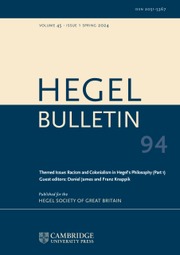Article contents
Do Functions Explain? Hegel and the Organizational View
Published online by Cambridge University Press: 02 September 2020
Abstract
In this paper I return to Hegel's dispute with Kant over the conceptual ordering of external and internal purposiveness to distinguish between two conceptions of teleology at play in the contemporary function debate. I begin by outlining the three main views in the debate (the etiological, causal role and organizational views). I argue that only the organizational view can maintain the capacity of function ascriptions both to explain the presence of a trait and to identify its contribution to a current system, for it is the only view that considers teleology as a natural cause. To establish how teleology can be considered as a natural cause, advocates of the organizational view return to Kant's analysis of internal purposiveness. However, while Kant identifies the requirements that an object must meet to satisfy the demands of teleological judgment, I suggest that he denies that we can know whether they are truly met. I argue that Hegel's philosophy of nature is better equipped to determine how internal purposiveness can be considered as a natural cause, for it grounds organization in a form of purposiveness that is more fundamental than a designer's intention.
- Type
- Articles
- Information
- Hegel Bulletin , Volume 41 , Special Issue 3: Hegel and the Philosophy of Biology , December 2020 , pp. 389 - 406
- Copyright
- Copyright © The Hegel Society of Great Britain, 2020
References
- 1
- Cited by




